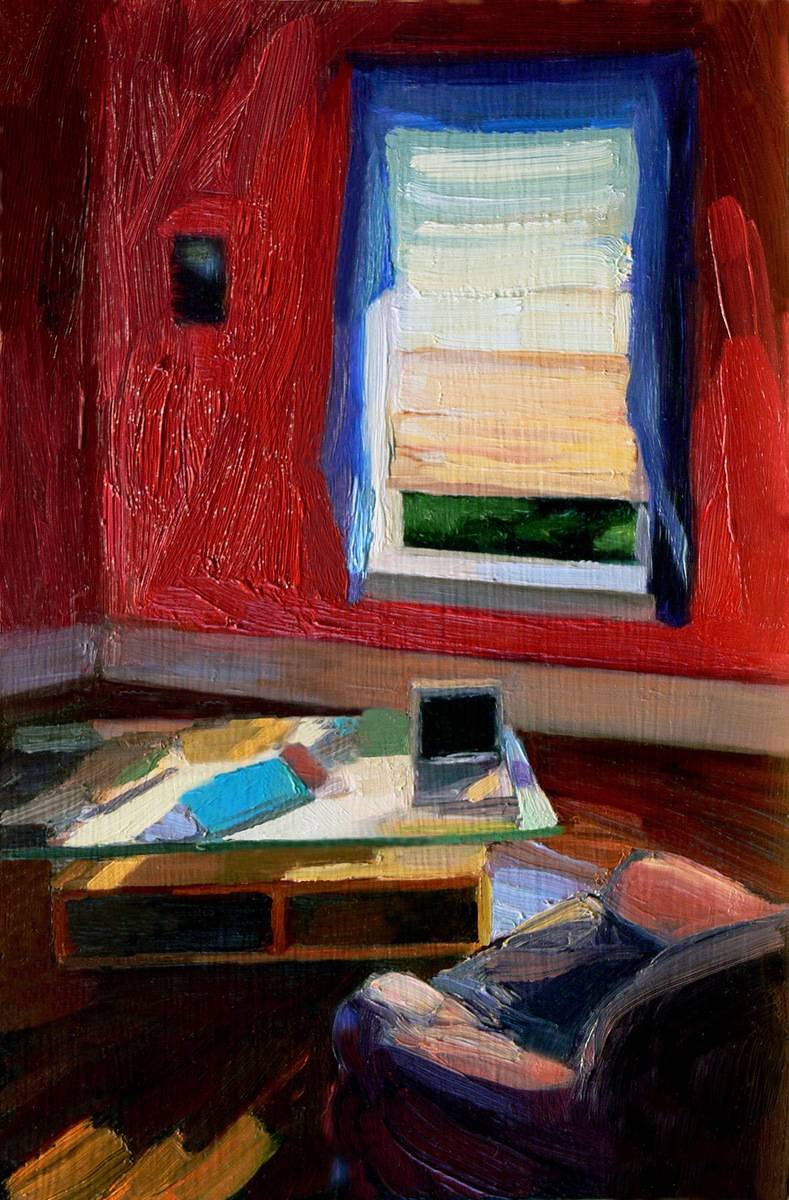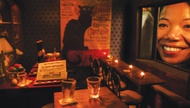Judging by these small studies of interiors, it seemed that Mary Connelly had never lived in a home she hasn’t wanted to paint. And I asked myself how rooms so vibrant with color and stuffed with furniture, flowers, knickknacks and books could feel so desolate. The answer slowly dawned on me after attending her recent evening lecture and morning critique session for local artists.
Connelly’s lecture was very personal and autobiographical. Her recent work has everything to do with the untimely death of her parents eight years ago, after which her senses, including her sense of color, went dead. She didn’t paint for a year. In a Hollywood-script moment, her senses returned at an artist’s residence in Paris, the “city of light.” Still grieving, she set out to memorialize her parents’ lives.
Returning to the large, narrative figuration she had practiced in graduate school, the Denver-based, New Jersey-bred Connelly referenced treasured photos and juxtaposed them with scenes and buildings significant to her family. Simultaneously, she began painting the small interior scenes on display now at the Charleston Heights Art Center, the emotional intensity of which belies the quotidian subject matter. She began to see interiors as repositories of memories that connect the past to the present.
As a child, Connelly often worked alongside her father—an inveterate tinkerer, hobbyist and craftsman. One of her most cherished memories is of their building a dollhouse together. Because her father also built furniture, a chair can be loaded with layers of association and memory. Several of the interior paintings feature a lovingly rendered red velvet gilt chair in which she remembers her parents sitting. For Connelly, an interior is haunted by people no longer there. In her few interiors featuring a figure, he or she seems ghostlike or in the distance, in the shadows or not quite present.
The Details

- Through December 28
- Charleston Heights Art Center, 800 S. Brush St., 229-6383
- More info on Mary Connelly at CHAC
- Beyond the Weekly
- Mary Connelly
Her use of color is anything but ghostlike; it’s vibrant and full-bodied. Although I responded viscerally to this, I didn’t realize the depth and breadth of her knowledge until I attended the critique she conducted the next morning. To each fledgling artist she gave valuable advice, particularly about color.
Connelly felt the color of one UNLV student’s flat painting of a bullfighter didn’t match the excitement of his subject. She advised him not to resort to black to make colors darker, but to go to the next darkest color on the color wheel—mix dioxin purple with ultramarine blue, which would darken without deadening.
Connelly advised another UNLV student, whose portrait of a man binding his wrists was painted in shades of blue, to consider other colors for his background, in order to “send a clear message” about his subject’s importance. And to a retired professional, whose trees were unconvincing and too high-key, Connelly suggested using complementary colors to create more interesting greens, e.g. adding alizarin to sap green.
Connelly is a rare bird, a painter whose work looks spontaneous, but whose effects are carefully calculated. Each hue and value is calibrated. Burnt orange and coral swish across the walls to perfectly complement the subtle shades of blue in the bed linens; impasto mixtures of different whites and yellows capture the difference between warm, incandescent light and cool daylight.
She possesses a wealth of knowledge about pigments and color, and her palette of 14 pigments—16 if you count the whites—reflects that. (Seven or eight is about average.) She employs double primaries, such as cadmium yellow light and cadmium yellow medium, which makes possible an enormous variety within a single color from the lowest to the highest key. One of my favorite paintings features a glass coffee table whose razor-sharp edge of emerald and lime green is slashed across the panel.
Initially crushed by grief, Connelly has found sustenance by using her prodigious talent to paint interiors that evoke memories and bring the past into the present. A sadness remains, but what is art if not beauty touched by our knowledge of our own mortality?





Previous Discussion: